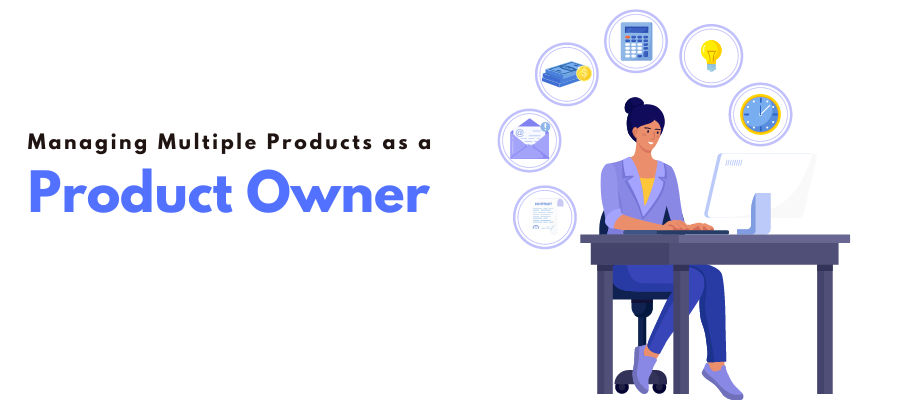Managing Multiple Products as a Product Owner

Managing multiple Products as a Product Owner requires a deep understanding of the role's unique responsibilities and the ability to balance competing demands. While "Product Manager" and "Product Owner" are sometimes used interchangeably, it's essential to recognize the differences between the two roles. This article will explore a Product Owner's essential duties and some strategies for managing multiple Products.
The Crucial Role of a Product Owner in a Scrum Team
In a Scrum Team, the Product Owner plays a crucial role in Product development, bridging the market and Developers. Unlike the Scrum Master, who focuses on ensuring the unit follows the Scrum methodology or the Developers, who is responsible for building the Product, the Product Owner maximizes the Product's value. This requires the Product Owner to have an external and internal view of the Product development process.
External view - Market Direction: As a Product Manager, the Product Owner must understand stakeholders' and customers' needs to act as their voice. By doing so, they ensure that the right solution is developed to meet market demands.
Internal view - Product Development Direction: The Product Owner works closely with the development team, considering their input and prioritising requirements. They also specify acceptance criteria, conduct tests, and verify that the Product increment meets the desired standards.
Given the Product Owner's central role, it's essential to understand their responsibilities and the skills required to excel in this position. Let's delve deeper into these responsibilities.
Strategies for Efficiently Managing Multiple Products as a Product Owner
- Crafting a Clear Product Vision:
As a Product Owner handling multiple Products, developing a clear and concise vision for each Product is essential to researching, analysing, and observing market trends. This helps prioritise the Product's goals and align the team's efforts towards achieving them. Effective communication of the Product Vision is crucial to ensure that everyone involved understands the Product's direction and purpose.
- Managing Multiple Product Backlogs:
As a Product Owner, you're responsible for creating and managing the Product's backlog. Managing multiple Product Backlogs can be challenging, but it's important to prioritise each backlog based on the Product's goals, market demand, and customer needs. Writing clear and concise descriptions of each item in the backlog is crucial, facilitating fluid and enriching dialogue during Product development. Creating a list of technical requirements that are understandable to everyone involved also helps manage multiple Product Backlogs.
- Defining Acceptance Criteria:
Defining acceptance criteria for each Product's user stories is essential for a Product Owner. These criteria are specific conditions of satisfaction that the Product must meet in terms of functional and non-functional requirements. Defining acceptance criteria helps in ensuring that the end Product meets the user's needs and expectations.
Constructing tests that verify compliance with the acceptance criteria is crucial, ensuring that each Product's quality is maintained. Managing multiple Products can be overwhelming, but defining acceptance criteria for each Product's user stories can help prioritise and streamline Product development efforts.
- Prioritise Needs:
As a Product Owner managing multiple Products, it's crucial to prioritise the individual requirements from the Product Backlog and determine which functions should be implemented in which order. This involves discussions with the scrum team to align efforts towards the Product goals. Monitoring progress and adjusting schedules after each sprint ensures smooth project management.
- Manage Development Stages:
After defining the Product priorities, users' stories, vision, and Product strategies, the Product Owner must monitor the development stages of each Product. This includes active involvement in Product planning, perfecting, reviewing, and sprint phases. Collaborating with stakeholders and the team to identify opportunities for improvement and support the sprint is also crucial.
- Monitor Progress:
Providing feedback is an essential responsibility of the Product Owner. The review meeting at the end of each sprint allows the Product Owner to present feedback and evaluate progress. The Product Owner defines the meeting's topics and invites important stakeholders to participate. Based on the results, the Product Owner sends input to the development team for improvement.
- Act as the Primary Liaison:
As a Product Owner managing multiple Products, effective communication and collaboration with the development team and the scrum master are essential. The Product Owner determines what needs to be done but allows the development team to choose how to implement it. Cooperation with various stakeholders ensures that all Product development efforts align with the vision and goals.
- Anticipating Client Needs as a Product Owner
As a Product Owner, one of the crucial responsibilities is to represent the customer's interests by anticipating their needs. Understanding each customer and their needs helps control the development process more effectively. Being an expert in the field, Product Owners must anticipate customers' needs to ensure that the developed Products cater to their requirements and exceed their expectations.
Effective communication with customers, stakeholders, and the development team is essential to understand the customers' feedback and suggestions to incorporate them into the Product development process. Anticipating client needs can ensure customer satisfaction and lead to the Product's success.
Conclusion
For efficient Product Management of multiple Products, different tools can be used to track the progress of Product features and release in real-time, from ideation to delivery.
Reference
- https://brainhub.eu/library/multiple-Product-owners-scrum



